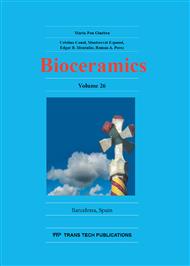p.332
p.341
p.345
p.351
p.357
p.363
p.367
p.373
p.379
Evaluation of Commercial Latex as a Positive Control for In Vitro Testing of Bioceramics
Abstract:
Several tests for the biological evaluation of bioceramic materials and medical devices are provided in specific international standards, where in vitro tests have a major role. Tests involving exposure of cells in culture require the use of validated positive controls, which, in the same preparation and treatment conditions, present a substantial and well-known cytotoxicity. The present work aimed to test and validate 3 different sources of low cost, commercially available latex, as positive controls in cytotoxicity tests for bioceramic materials performed by indirect exposure. The tested origins for latex samples were: surgical gloves without powder, 100% pure amber latex hospital-grade tourniquets and 60 % latex White tubing. MC3T3-E1 murine pre-osteoblasts in culture were exposed to conditioned media (extracts) of each material tested, along with sintered stoichiometric hydroxyapatite bioceramics, and polystyrene beads as negative control. Cell viability was determined by XTT and Crystal Violet Exclusion tests. Concentration curves of the extracts were performed to obtain the DC50. Only the 100% pure amber latex tubing was proven to be cytotoxic, with cell survival less than 5%. This material did not affected neighboring groups at the same experimental system. Moreover, latex samples showed great repeatability in different tests against latex and biomaterials, with consistent toxicity under 20% cell survival as shown in 3 different cell viability parameters. We conclude that fragments of latex ambar tubing are suited as effective positive controls in tests of medical bioceramic materials.
Info:
Periodical:
Pages:
357-362
Citation:
Online since:
November 2014
Keywords:
Price:
Сopyright:
© 2015 Trans Tech Publications Ltd. All Rights Reserved
Share:
Citation:


